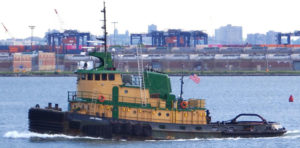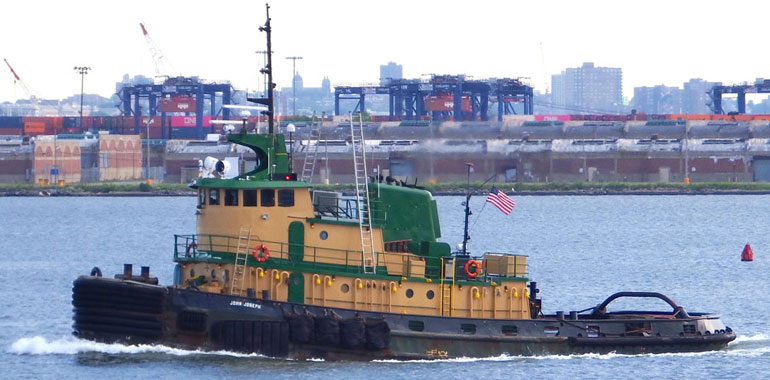Zero non-conformities is what you want to hear when the U.S. Coast Guard inspects your tugboat. Once you’ve prepared your vessel, the inspectors come aboard to peruse your paperwork. They ask you pointed questions, to which they expect straightforward answers. Perusal completed, they then scrutinize all of the related safety systems, from bilge to antennas — even the ship’s bell.

You must demonstrate for them that you can proficiently operate all systems, such as those for firefighting. Then, after a visit of several hours, when the inspectors announce they’ve found zero non-conformities and issue the certificate of inspection (COI), it’s a moment for the entire crew and company to celebrate.
For the crew and owners of Stasinos Marine’s John Joseph, celebrating the COI in September meant roast beef sandwiches with a side of company pride. The sandwiches from a deli along the Mystic River in Boston are now a Stasinos COI tradition — thin slices with mayonnaise, barbecue sauce and cheese.
“Getting the COI makes this a pretty special day,” said Jon Stasinos, co-founder of the Weymouth, Mass.-based company, between bites of his celebratory sandwich. He attributed the firm’s success to the skill, flexibility and commitment of its crews, and the crews’ response to the company’s commitment to them.
“If you want to attract and keep good people, professionals, you need to treat them well, offering the competitive day rates and benefits,” he said. “We researched benefits packages and got the best we could. I have the same benefits as my crews. It’s big-company compensation within a small family-run business.”
Jon and James Stasinos, identical twins, established the company in 2017 with a single boat. They added two tugboats in 2020, bringing the number of vessels in their fleet to four. All are solid boats painted with the operator’s distinctive livery: green and buff.
From a young age, the Stasinos twins knew they wanted to work on the water. At age 10, they headed to the docks in Plymouth, Mass., to clean fish and rinse down boats. “It was a good deal — for the boat owners,” James joked. At 16, they began working as deck hands on Boston ferries and whale-watch vessels. At 17, each earned their 100-ton captain’s license, making them among the youngest holders of that document. As if this were not enough, in their high school and college years they showed early entrepreneurial spirit by operating a fleet of four ice cream trucks under the name Captain Cones.
The brothers formalized their maritime training less than 10 years ago at SUNY Maritime, where they captained dinner boats and water taxis in New York Harbor. After their time at the academy, they chose jobs that ultimately served them well when they launched their own company. Jon captained ferries, and James worked as a port captain for Boston Line & Service and a relief captain for Rhode Island Fast Ferry. James also was a captain for the construction and commissioning of Atlantic Pioneer, the first U.S.-built crew transfer and maintenance vessel for an offshore wind project (Deepwater Wind southeast of Block Island).
Growing a company at any time requires capital and a plan. During a pandemic, they become even more crucial. According to James, the Stasinos business model involved buying select old equipment, reconditioning it, then putting it to work to earn money. The brothers’ extensive background in passenger vessel compliance — meeting Subchapter T and Subchapter K requirements — was excellent preparation for compliance with Subchapter M. “We’ve moved from the heavily regulated passenger industry to a less heavily regulated one with tugboats,” James said. “We’re no strangers to the CFR (Code of Federal Regulations).”
John Joseph is the second vessel that Stasinos Marine has shepherded through the COI process. Assisting was Birk Thomas, an auditor at Tug and Barge Solutions, an independent contractor that specializes in guiding towing companies toward compliance with Subchapter M. For operators like Stasinos Marine — too small to have a full-time safety and compliance department — Thomas serves as a consultant in such matters.
Stasinos Marine’s fleet includes three tugboats that complement each other. Charles James, the first Stasinos vessel to receive its COI, was built in 1985 for dredge work. It is one of five tugs from various operators currently working on contract with the principal dredging company for the Boston Harbor Deepening Project, expected to be complete by the end of 2021.
“Charles James is the ideal dredge-assist boat: ABS-exempt, shallow draft, open props, adequate horsepower and low fuel consumption,” James Stasinos said. “And all that in a 78-by-26-foot package.”
John Joseph, an offshore tug home-ported in Boston, delivers 3,400 horsepower from two EMD 12-645 E2 diesels. It is equipped with safety systems that exceed requirements for the COI, including a bridge navigational watch alarm system (BNWAS) and forward-looking infrared (FLIR) cameras. It regularly tows Cargomaster, a 300-by-43-foot dry-bulk barge that is authorized to transport such cargoes as scrap metal, sugar, wood chips and coal. Currently, the barge’s cargo is shredded ferrous scrap loaded from a metal recycling facility in Everett, Mass.
“People love our industry (and) photos of tugboats, but they don’t understand it,” James said. “They don’t see what’s significant about this Jones Act vessel doing short-sea shipping, a U.S.-owned and -crewed vessel delivering ferrous scrap to a U.S. minimill in a U.S. port, Charleston, S.C.”
Minimills produce fresh steel products from recycled scrap metal. Since 2006, more than half of U.S. steel production has come from minimills.
“Backhaul is fresh U.S. steel in special-order rolls or beams delivered to another U.S. port,” James said. “This is a regular run. I wish more people understood that ferrous scrap gets recycled into fresh steel in the United States, not in some foreign country.”
Jon Stasinos said the company is actively seeking other cargoes, mentioning wood chips, wood pulp and raw sugar as possibilities. COVID-19, the bane of many enterprises in 2020, has caused some potential cargo contracts to temporarily disappear. COVID also has complicated crew changes due to new protocols, and time is wasted going to several stores while grub shopping since some items are still limited. COVID-related paperwork is even required when loading and discharging the ferrous scrap, although minimal contact occurs between yard crews and tug crews.
Meaghan Marie, Stasinos Marine’s most recent acquisition, is based in New York for spot work. The duty is as unpredictable as it sounds, although the tugboat’s availability is known because of long-term relationships the Stasinos brothers have in the harbor, and their networking through committees of the Maritime Association of the Port of New York and New Jersey. Meaghan Marie is at a dock and ready to work; a call might come in at any time of night or day, fair weather or most foul, and then time is critical. Someone else might have an unanticipated but urgent need in tight berths, or there might be a “tide job” on a creek navigable only during a short period each day. Think of a tow truck getting a call at 0300 for a car off the road during an ice storm.
A fourth Stasinos vessel, Brinn Courtney, is a research boat that works with various bathymetric survey vessels in the wind farm projects off southern New England.
Stasinos Marine is the creation of two young maritime entrepreneurs. With their distinctive green-and-buff vessels and passion for working on the water, Jon and James have adapted to new industry realities and are open for business. •

